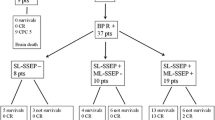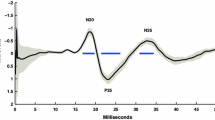Abstract
A comatose patient suffering from diffuse cerebellar haemorrhage developed apnoea and brainstem areflexia, i.e. the clincial signs of brain death. However, median nerve somatosensory evoked potential testing 2.5 h and 22 h after the onset of this clinical syndrome showed cortical potentials partly preserved; these were abolished 46 h after the beginning of the clinical signs of brain death. This case report underlines the need for electrophysiological confirmation of brain death in patients with primarily infratentorial lesions.
Similar content being viewed by others
References
Anziska BJ, Cracco RO (1980) Short latency somatosensory evoked potentials in brain dead patients. Arch Neurol 37:222–225
Belsh JM, Chokroverty S (1987) Short-latency somatosensory evoked potentials in brain dead patients. Electroencephalogr Clin Neurophysiol 68:75–78
Besser R, Dillmann U, Henn M (1988) Somatosensory evoked potentials aiding the diagnosis of brain death. Neurosurg Rev 11:171–175
Chancellor AM, Frith RW, Shaw NA (1988) Somatosensory evoked potentials following severe head injury: loss of the thalamic potential with brain death. J Neurol Sci 87:255–263
Conference of Medical Royal Colleges and their Faculties in the United Kingdom (1976) Diagnosis of brain death. BMJ 2:1187–1188
Desmedt JE, Cheron G (1981) Non-cephalic reference recording of early somatosensory potentials to finger stimulation in adult or aging normal man: differentiation of widespread N18 and contralateral N20 from the prerolandic P22 and N30 components. Electroencephalogr Clin Neurophysiol 52:553–570
Facco E, Casartelli Liviero M, Munari M, Toffoletto F, Baratto F, Giron GP (1990) Short latency evoked potentials: new criteria for brain death? J Neurol Neurosurg Psychiatry 53:351–353
Ferbert A, Buchner H, Ringelstein EB, Hacke W (1986) Isolated brain-stem death: case report with demonstration of preserved visual evoked potentials. Electroencephalogr Clin Neurophysiol 65:157–160
Frowein RA, Gänshirt H, Hamel E, Haupt WF, Firsching R (1987) Hirntod-Diagnostik bei primärer infratentorieller Hirnschädigung. Nervenarzt 58:165–170
Goldie WD, Chiappa KH, Young RR, Brooks EB (1981) Brainstem auditory and short-latency somatosensory evoked responses in brain death. Neurology 31:248–256
Grigg MM, Kelly MA, Celesia GG, Ghobrial MW, Ross ER (1987) Electroencephalographic activity after brain death. Arch Neurol 44:948–954
Haupt WF (1987) Multimodale evozierte Potentiale und Hirntod. Voraussetzungen, Aussagen und Probleme. Nervenarzt 58:653–657
Korein J (1984) The diagnosis of brain death. Semin Neurol 4:52–72
Mauguière F, Grand C, Fischer C, Courjon J (1982) Aspects des potentiels évoqués auditifs et somesthésiques précoces dans les comas neurologiques et la mort cérébrale. Rev EEG Neurophysiol 12:280–286
Mauguière F, Desmedt JE, Courjon J (1983) Neural generators of N18 and P14 far-field somatosensory evoked potentials studied in patients with lesions of thalamus or thalamocortical radiations. Electroencephalogr Clin Neurophysiol 56:283–294
Pallis C (1982) ABC of brain stem death: from brain death to brain stem death. BMJ 285:1487–1490
Pendl G (1986) Der Hirntod. Eine Einführung in seine Diagnostik und Problematik. Springer, Wien New York
Report of the medical consultants on the diagnosis of death for the President's Commission for the study of ethical problems in medicine and biomedical and behavioral research: guidelines for the determination of death (1981) JAMA 246:2184–2186
Stellungnahme des Wissenschaftlichen Beirates der Bundesärtzekammer zur Frage der Kriterien des Hirntodes (1991) Dtsch Ärztebl 88:2855–2860
Stöhr M, Riffel B, Trost E, Ullrich A (1987) Short-latency somatosensory evoked potentials in brain death. J Neurol 234:211–214
Tomberg C, Desmedt JE, Ozaki I, Noel P (1991) Nasopharyngeal recordings of somatosensory evoked potentials document the medullary origin of the N18 far-field. Electroencephalogr Clin Neurophysiol 80:496–503
Trojaborg W, Jorgensen EO (1973) Evoked cortical potentials in patients with “isoelectric” EEGs. Electroencephalogr Clin Neurophysiol 35:301–309
Urasaki E, Wada S, Kadoya C, Yokota A, Matsuoka S, Shima F (1990) Origin of scalp far-field N18 of SSEPs in response to median nerve stimulation. Electroencephalogr Clin Neurophysiol 77:39–51
Wagner W (1991) SEP testing in deeply comatose and brain dead patients: the role of nasopharyngeal, scalp, and earlobe derivations in recording the P14 potential. Electroencephalogr Clin Neurophysiol 80:352–363
Author information
Authors and Affiliations
Rights and permissions
About this article
Cite this article
Wagner, W., Ungersböck, K. & Perneczky, A. Preserved cortical somatosensory evoked potentials in apnoeic coma with loss of brain-stem reflexes: case report. J Neurol 240, 243–246 (1993). https://doi.org/10.1007/BF00818712
Received:
Revised:
Accepted:
Issue Date:
DOI: https://doi.org/10.1007/BF00818712




